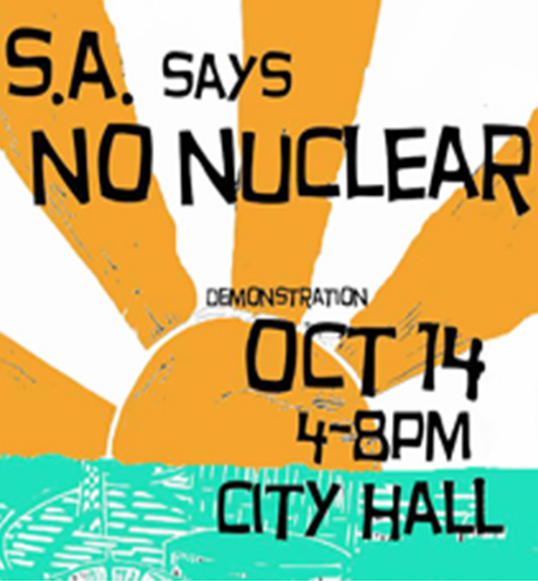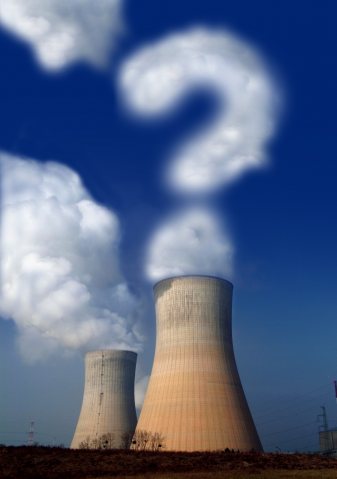With just two days before San Antonio City Council was to vote to approve $400 million in bonds to move forward with the South Texas Nuclear Project two reactor expansion, officials announced yesterday that the cost estimate for the project had ballooned by up to $4 BILLION. That means that the new price tag on the new reactors, up from $13 Billion, is now a whopping $17 Billion (and don’t forget that even $13 Billion was a big jump from the original cost estimate of $5.4 Billion). As a result, the Council has postponed the vote until January.
This is a huge victory for environmentalists, social justice workers, and citizen activists who have been tirelessly organizing opposition to new nuclear reactors. If these concerned citizens hadn’t gotten involved, the City Council would have voted to approve the bonds a month ago, with no option to renegotiate their contract or pricing. Because citizens got educated and involved, City Council was forced to delay the vote until they had all the information. And the information, as it turns out, is that the cost estimates that groups like Public Citizen and SEED Coalition have been predicting for more than a year (up to $17.5 Billion according to a 2008 study by Arjun Makhijani and as much as $22 Billion according to analyst Clarence Johnson), far from a Cassandra cry, have been right on the money all along.
For all the dirty details, be sure to read the San Antonio Express-News’ breaking article Nuclear cost estimate rises by as much as $4 billion and the San Antonio Current’s blog post Nuke Collider: San Antonio delays $400 million nuke bond vote over Toshiba cost surge. And courtesy of the unstoppable Greg Harman at the Current, check out the following video from the emergency press conference CPS officials and the Mayor’s office held yesterday, a MUST WATCH:
[youtube=http://www.youtube.com/watch?v=nwdivqvtjgc&feature=player_embedded]
What I find most interesting about this whole mess is that CPS insiders knew a week and a half ago that the costs were up by $4 Billion, but neglected to tell the Mayor or City Council until yesterday. And even then, it didn’t come as a formal announcement — the cat was only let out of the bag because, as the Express-News reports, an aide of the Mayor confronted CPS about rumors of a cost increase.
CPS interim General Manager Steve Bartley said the utility’s main contractor on the project, Toshiba Inc., informed officials that the cost of the reactors would be “substantially greater” than CPS’ estimate of $13 billion, which includes financing.
He said utility officials found out about the increase “within the last week and a half or so.”
But the mayor said he only learned the news Monday night after an aide asked Bartley about rumors of a cost estimate increase.
Castro said he didn’t know whether CPS would have divulged the increase to the council before its vote Thursday had his aide not directly questioned utility management.
“One would hope otherwise, but the evidence seems to suggest that they were less than proactive,” he said.
Sounds like CPS was going to wait until after Thursday’s vote to share their special need-to-know information, and that if it weren’t for those meddling kids they would have gotten away with it too.
Any way you look at it, yesterday’s announcement is fortuitous for the City of San Antonio. Now City Council has a better idea of the real costs they are looking at with the project, and hopefully will think twice about placing their trust in CPS Energy now that they’ve been burned by the utility’s untransparent business practices. With two months time until the vote, City Council now has plenty of time to order an independent study to model various energy scenarios and present a slew of options (besides just “nuclear or nothing”) for San Antonio’s energy future — including a heavy mix of renewable energy and efficiency. An outside study to model alternatives would present City Council with the most cost-effective, least risky, most environmentally sustainable plan possible. CPS claims to have done a ‘thorough’ investigation of these options, but just as they conveniently underestimated the cost of nuclear, they have overestimated the cost of renewable energies such as wind, solar, storage, and energy efficiency to the point of absurdity. With two months to work at it, there is no reason why San Antonio shouldn’t have a green plan to put up against the nuclear plan by January. They nearly voted to approve the project this week without the full range of information. San Antonio City Council can’t put themselves in that situation again.
But don’t take my word for it. Check out the following statements from Tom “Smitty” Smith, director of Public Citizen’s Texas Office and Karen Hadden, director of the SEED Coalition:
Cost Increase of South Texas Project Shows Nuclear Power Is Too Expensive, Too Risky
Statement of Tom “Smitty” Smith, Director, Public Citizen’s Texas Office
We can’t think of any good reasons for the San Antonio City Council to continue with this project when there are far less expensive alternatives readily available. Investing in wind and solar makes much more sense and carries none of the risks – both the extreme financial risk that CPS wants taxpayers to bear and the health and safety risks inherent with nuclear power. If the City Council continues with this project, the average ratepayers will see their utility bills increase by 50 percent.
If San Antonio citizens hadn’t stepped to the plate, the City Council would have voted for the STP a month ago and the city would have been another $400 million in the hole with no option to renegotiate. But citizens got educated and got involved. Their involvement made the City Council delay the vote until they had all the information.
We know the San Antonio City Council is too smart to continue to support this boondoggle. Nuclear power is too expensive and too risky to use. It’s time for the San Antonio City Council to pull the plug on the STP expansion.
Statement of Karen Hadden, executive director, Sustainable Energy and Economic Development (SEED) Coalition:
We aren’t surprised to hear that the latest cost estimate for the South Texas Project puts the price to build two new nuclear reactors at $17 billion, $4 billion more than what CPS Energy said in June and more than three times the project’s original $5.4 billion price tag. We’ve been saying for two years that CPS has been feeding the public lowball estimates that wouldn’t hold up to reality.
Read Full Post »


 Nuclear or Not? That’s the question on everyone’s lips in San Antonio these days, but some are still waiting to hear from the experts before they make a decision. What are the consequences and risks? What affordable and safe options exist? We want to know, but we want to hear from folks we can trust.
Nuclear or Not? That’s the question on everyone’s lips in San Antonio these days, but some are still waiting to hear from the experts before they make a decision. What are the consequences and risks? What affordable and safe options exist? We want to know, but we want to hear from folks we can trust.

